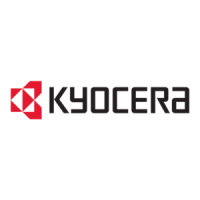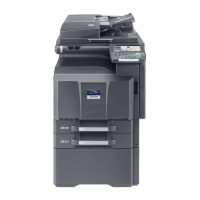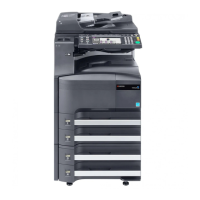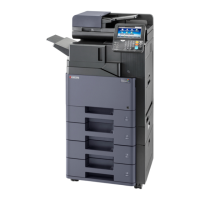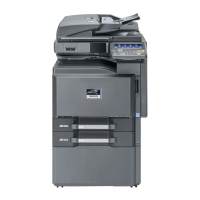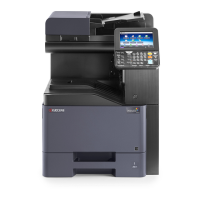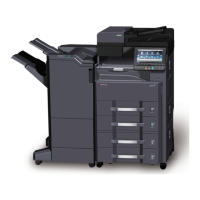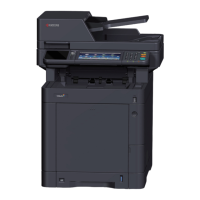Do you have a question about the Kyocera Taskalfa 3051 ci and is the answer not in the manual?
Initial steps and prerequisites for installing the printer driver on your system.
Quick and easy installation of driver and features for USB or network connections.
Detailed installation allowing selection of specific drivers and utilities.
Allows modification of driver properties such as printer name, sharing, and default settings.
Process for updating printer driver components to the most recent version.
Process for removing installed printer drivers and associated components from the system.
How to access and modify the default settings for the printer driver for all applications.
Illustrates driver settings through visual representations within the dialog boxes.
How to choose and set the Page Description Language (PDL) for temporary driver settings.
Allows users to check the print job appearance and settings before printing.
Steps to open the Device Settings window to configure printer system options and memory.
Configure optional devices like source, finishing, and job storage to extend printer capabilities.
Settings managed by an administrator, including access control, interface display, and passwords.
Manages job restriction and privileges based on user identity for secure printing.
System for recording and controlling print jobs based on assigned account IDs for usage tracking.
Specifies how documents are laid out and printed, with options like PCL XL, PCL 5c, KPDL, and PDF.
Adjust media source values, override application collation, and combine source/media type lists.
Controls page orientation (portrait, landscape) for print jobs.
Specifies the order of pages for multiple copy jobs, printing sets sequentially.
Enables printing on both sides of a page, with options for long or short edge binding.
Allows customization of the Quick Print tab to display frequently used print options.
Save and apply sets of driver settings as named profiles for consistent print jobs.
Associate specific print profiles with applications for automatic setting application.
Controls output page size and allows creation of custom page sizes for specific printing needs.
Specifies the paper tray or cassette used for a print job, with auto-selection options.
Sets the number of copies to be printed for a document, up to 999.
Selects between full-color printing or black-and-white printing for color-capable models.
Enables printing on both sides of each page, with options for long or short edge binding.
Prints several document pages onto a single sheet of paper to conserve paper and for review.
Increases or decreases text and graphics size on a page to fit specific requirements.
Enables margin-less printing by extending toner to the edge, allowing trimming.
Prints documents in a larger format by dividing them into segments for assembly as a poster.
Creates a two-page layout printed on both sides of paper, folded into a booklet format.
Stacks print jobs to distinguish them, often used with offset printing.
Physically shifts each print job in the output tray for consistent stacking.
Folds documents into thirds, like a brochure or pamphlet, with options for print side and fold direction.
Folds documents in half, like a brochure or pamphlet, with options for print side and number of sheets.
Aligns matching sides of different page sizes for consistent finishing, especially with mixed media.
Increases left and top margins to accommodate binding, stapling, or hole punching.
Creates stapled document sets, with options for position and number of sheets per set.
Creates punched holes along the edge of pages for binding or placement in binders.
Selects print quality (High or Custom/EcoPrint) to manage toner usage and print appearance.
Overlaps colors slightly to correct minor alignment issues in color printing for better image quality.
Manages how TrueType fonts are sent to the printing system, affecting speed and quality.
Selects options for optimizing the appearance and quality of printed graphics.
Methods for controlling printer color processing and matching for accurate color reproduction.
Customizes color spaces by adjusting hue, saturation, lightness, or color balance.
Modifies brightness and contrast of graphics for black and white printing to improve image clarity.
Adds cover pages to documents, allowing different paper weights or colors for front and back covers.
Inserts preprinted pages or different paper types at specified points within a print job.
Inserts a backing sheet between printed transparencies to protect them.
Inserts tab divider sheets to section documents, with options for custom tabs and tab text.
Saves print jobs in system memory for later printing or reprinting, enhancing print management.
Stores print jobs in user-assigned custom boxes on the printer's hard disk for later access.
Stores jobs securely on the hard disk, requiring a four-digit access code for printing.
Assigns unique identifiers to print jobs for easy searching and management within the printing system.
Inserts command files at the beginning or end of print jobs for custom outputs like logos or macros.
Places a recognizable image or pattern on pages, useful for branding or identification.
Prints a nearly invisible image or text that appears on photocopies to deter unauthorized reproduction.
Matches single colors accurately in print jobs, especially for solid color graphics like logos.
Displays printing system status messages and alerts in a window for real-time monitoring.
Uses Enhanced MetaFile format for faster application control return during printing of large documents.
Allows selection of local or server profiles for print jobs in a client-server environment.
Initial steps and prerequisites for installing the printer driver on your system.
Quick and easy installation of driver and features for USB or network connections.
Detailed installation allowing selection of specific drivers and utilities.
Allows modification of driver properties such as printer name, sharing, and default settings.
Process for updating printer driver components to the most recent version.
Process for removing installed printer drivers and associated components from the system.
How to access and modify the default settings for the printer driver for all applications.
Illustrates driver settings through visual representations within the dialog boxes.
How to choose and set the Page Description Language (PDL) for temporary driver settings.
Allows users to check the print job appearance and settings before printing.
Steps to open the Device Settings window to configure printer system options and memory.
Configure optional devices like source, finishing, and job storage to extend printer capabilities.
Settings managed by an administrator, including access control, interface display, and passwords.
Manages job restriction and privileges based on user identity for secure printing.
System for recording and controlling print jobs based on assigned account IDs for usage tracking.
Specifies how documents are laid out and printed, with options like PCL XL, PCL 5c, KPDL, and PDF.
Adjust media source values, override application collation, and combine source/media type lists.
Controls page orientation (portrait, landscape) for print jobs.
Specifies the order of pages for multiple copy jobs, printing sets sequentially.
Enables printing on both sides of a page, with options for long or short edge binding.
Allows customization of the Quick Print tab to display frequently used print options.
Save and apply sets of driver settings as named profiles for consistent print jobs.
Associate specific print profiles with applications for automatic setting application.
Controls output page size and allows creation of custom page sizes for specific printing needs.
Specifies the paper tray or cassette used for a print job, with auto-selection options.
Sets the number of copies to be printed for a document, up to 999.
Selects between full-color printing or black-and-white printing for color-capable models.
Enables printing on both sides of each page, with options for long or short edge binding.
Prints several document pages onto a single sheet of paper to conserve paper and for review.
Increases or decreases text and graphics size on a page to fit specific requirements.
Enables margin-less printing by extending toner to the edge, allowing trimming.
Prints documents in a larger format by dividing them into segments for assembly as a poster.
Creates a two-page layout printed on both sides of paper, folded into a booklet format.
Stacks print jobs to distinguish them, often used with offset printing.
Physically shifts each print job in the output tray for consistent stacking.
Folds documents into thirds, like a brochure or pamphlet, with options for print side and fold direction.
Folds documents in half, like a brochure or pamphlet, with options for print side and number of sheets.
Aligns matching sides of different page sizes for consistent finishing, especially with mixed media.
Increases left and top margins to accommodate binding, stapling, or hole punching.
Creates stapled document sets, with options for position and number of sheets per set.
Creates punched holes along the edge of pages for binding or placement in binders.
Selects print quality (High or Custom/EcoPrint) to manage toner usage and print appearance.
Overlaps colors slightly to correct minor alignment issues in color printing for better image quality.
Manages how TrueType fonts are sent to the printing system, affecting speed and quality.
Selects options for optimizing the appearance and quality of printed graphics.
Methods for controlling printer color processing and matching for accurate color reproduction.
Customizes color spaces by adjusting hue, saturation, lightness, or color balance.
Modifies brightness and contrast of graphics for black and white printing to improve image clarity.
Adds cover pages to documents, allowing different paper weights or colors for front and back covers.
Inserts preprinted pages or different paper types at specified points within a print job.
Inserts a backing sheet between printed transparencies to protect them.
Inserts tab divider sheets to section documents, with options for custom tabs and tab text.
Saves print jobs in system memory for later printing or reprinting, enhancing print management.
Stores print jobs in user-assigned custom boxes on the printer's hard disk for later access.
Stores jobs securely on the hard disk, requiring a four-digit access code for printing.
Assigns unique identifiers to print jobs for easy searching and management within the printing system.
Inserts command files at the beginning or end of print jobs for custom outputs like logos or macros.
Places a recognizable image or pattern on pages, useful for branding or identification.
Prints a nearly invisible image or text that appears on photocopies to deter unauthorized reproduction.
Matches single colors accurately in print jobs, especially for solid color graphics like logos.
Displays printing system status messages and alerts in a window for real-time monitoring.
Uses Enhanced MetaFile format for faster application control return during printing of large documents.
Allows selection of local or server profiles for print jobs in a client-server environment.
| Print Technology | Laser |
|---|---|
| Resolution | 600 x 600 dpi, 9600 x 600 dpi interpolated |
| Duplex Printing | Yes |
| Memory | 2 GB RAM |
| Standard Functions | Print, Copy, Scan, Fax |
| Print Speed | 30 ppm |
| Scan Resolution | 600 x 600 dpi |
| Paper Capacity | 1, 150 sheets |
| Copy Speed | 30 ppm (Black/Color) |
| Fax Resolution | 400 x 400 dpi (Superfine) |
| Network Connectivity | 10/100/1000BaseTX Ethernet, High-Speed USB 2.0 |
| Hard Drive | 160 GB |
